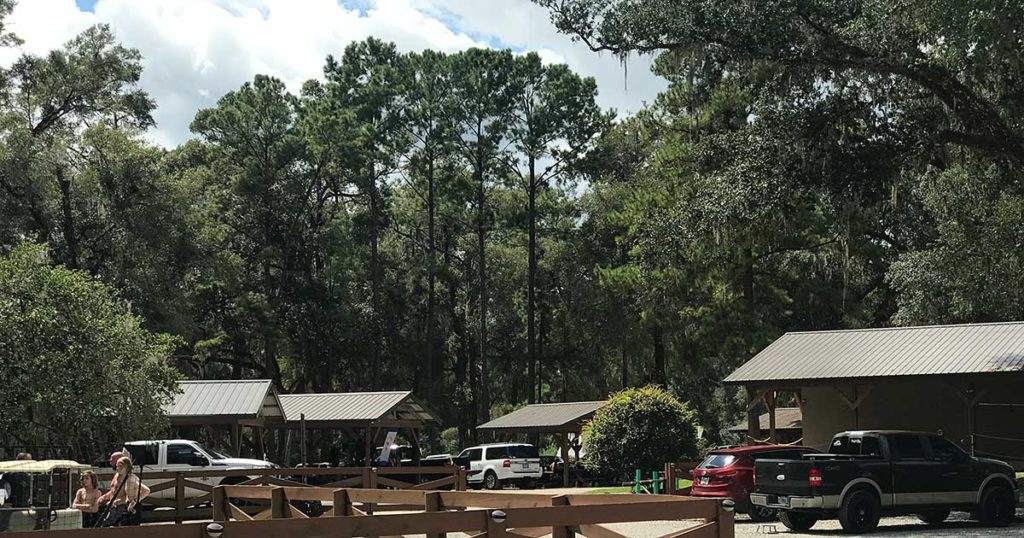Here’s irony for you: The most overlooked feature of the Grotto is the feature that overlooks all of us. We are talking about the tall trees that dot the field on the far side of the parking lot.
Taller than you think
From time to time we will ask visitors how tall they think these trees are. We will usually get answers ranging from 40 to 60 feet. These answers are not even close.
The tallest trees in the Grotto stand well over 100 feet . And there are several that reach this height. This begs the question, How did these trees get so tall? To answer that question, you need to know something about the area’s history.
A history often forgotten
The history of north-central Florida is very poorly documented. While Hollywood has fallen all over itself to produce movies and television shows about the Old West when was that last time you saw similar entertainment featuring Florida’s spring country? This is a shame as what history we do know is fascinating.
For instance, while visitors to Saint Augustine can see buildings dating back to the early 1600s, many early north-Florida towns have vanished without a trace. Take the original town of Troy, for example.
Located near the banks of Troy spring, the town of Troy burned to the ground at least twice. Thanks to the construction techniques of the time, no foundations nor other remnants remain. That which did not burn was salvaged to rebuild elsewhere.
After Troy burned a second time, residents gave up and moved the Lafayette County seat to Mayo. This was before the advent of photography, so no images survive that tell us what the town looked like.
Before the outsiders came
It is impossible to know with any certainty what north-central Florida looked like before the Europeans arrived. Based on what we know, there is a good possibility the trees were larger, thicker and spaced further apart. In other words, nothing at all like what we see today.
Native settlements would often surround the springs, which provided drinking water and helped attract game. The Santa Fe River near Ginnie Spring attracted natives as it was an excellent source of flint. Flint was essential for the indigenous people who used it for both tools and weapons.
“Like a plague of locusts…”
The forests of pre-Columbian North Florida were home to many live oak and cypress trees — both valuable for their lumber. Apparently, during the late 1800s, loggers moved across this part of the state “like a plague of locusts,” cutting down everything in sight.
The harvested logs would be dragged to the nearest river, such as the Suwannee, Santa Fe, Ocklawaha and Saint John. From here they would be floated downriver to lumber mills. Not every log made it. Some sank to the bottom where many remain to this day.
The History Channel series Ax Men featured a segment on divers who make their living recovering some of these logs. Even after more than a century, a single log can be worth thousands of dollars. Of course, to recover them, you have to be comfortable diving in near-zero visibility with unusually large reptiles for company.
After the loggers left, the forests grew back, but nothing at all like they looked before.
What changed?
The next time you drive through north Florida, pay attention to the trees lining the side of the road. Some of these will be pulpwood forests, artificially planted softwoods that will be harvested every 20 years or so and sent to the paper mill.
The stands of trees that are not pulpwood will seldom be more than around 45-50 feet high, The trees will be packed more closely together and, between them, you will see a thick growth of underbrush.
It has only been in the past few decades that we have fully understood the importance of naturally occurring forest fires. Usually the result of lightning strikes, these fires are essential in cleaning out the underbrush so that the larger trees have the opportunity to grow.
Once the loggers left, the population of north Florida grew. This meant that every time a naturally occurring forest fire broke out, there were plenty of people available who would rush to put it out. They thought that, in so doing, they were helping to protect the forest. They weren’t.
The result is that today’s forests are stunted facsimiles of their former glory, with thick underbrush preventing the trees from reaching their full potential.
A look back in time
If you want to get a feel for the way north-central Florida looked in the days when the native Timucuans were the only human inhabitants, visit a site like Orange Grove Sink in Wes Skiles Peacock Springs State Park. On the north side of the sink, you will find an area of several widely spaced live oaks. These are tall with trunks several feet thick.
How did they get this way? Florida’s springs have always attracted visitors. In an effort to reach the water, these folks would trample down the underbrush, much the way naturally occurring forest fires used to burn it out. This gave the larger, stronger trees a chance to grow.
This is a pattern you will find repeated at many Florida springs. We assume it played a part in the development of Blue Grotto.
More lost history
We don’t know a lot about the history of the Grotto prior to when Tom McQuarrie began purchasing the property surrounding the site in the 1960s. What became today’s tallest trees were already in place at that time. We’re just grateful they are.
The next time you visit the Grotto, take a moment to stand back and appreciate these natural wonders. They are what help make the scenery above water every bit as beautiful as what you will find underwater.


